The global 4PL logistics market value stood at $49.84 billion in 2021 and is expected to grow at a CAGR of 7.1%.
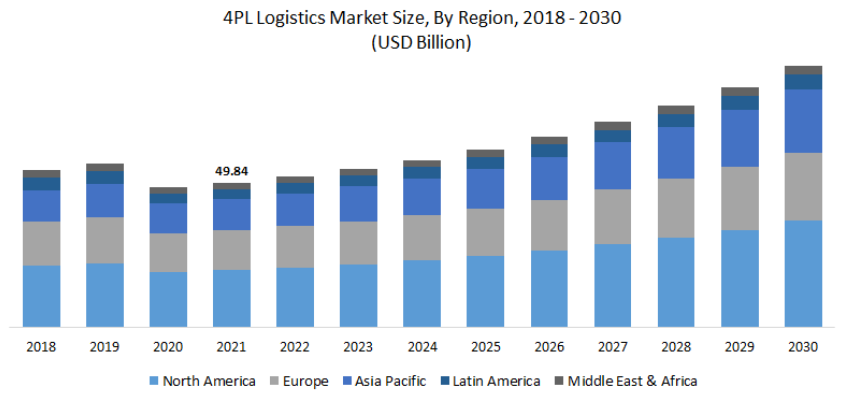
The industry experienced setbacks during the covid-19 pandemic owing to the breakdown of supply chains around the world.
But, these setbacks turned more industries to opt for 4PL solutions to develop more agile and efficient supply chains that do not depend on the company’s owned resources.
A variety of industries use 4PL solutions to run their supply chains. These include retail, aerospace, automotive, food & beverages, healthcare, consumer electronics, and more.
In this article, we will understand the meaning of 4PL logistics with examples. We will also cover the services provided by a 4PL company and the benefits of using 4PL solutions for your business.
What is 4PL Logistics?
4PL stands for fourth party logistics. It is a supply chain management model wherein a logistics company handles all aspects of a company’s supply chain. 4PL solutions include all aspects of supply chain management such as procurement, storage, transportation, order fulfilment, and so on.
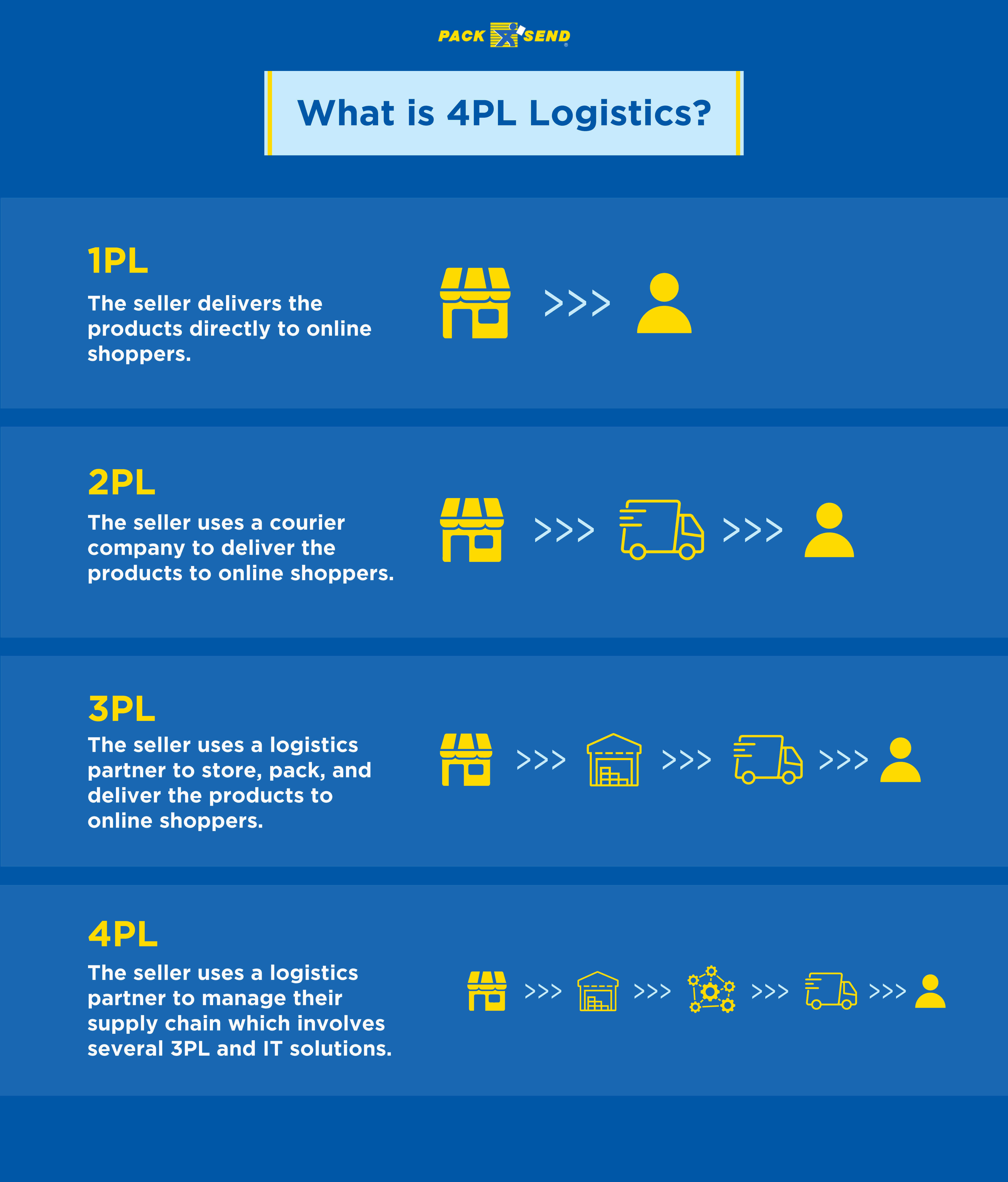
A 4PL provider serves as an integrator for a company’s supply chain. They leverage resources and technology to streamline the supply chain. In the fourth-party logistics service, the logistics company handles all stages of the supply chain except manufacturing.
4PL Services
A 4PL provider can facilitate a business with the following services:
- Supply Chain Planning & Management
- Logistics Strategy
- Warehousing
- Inventory Planning & Management
- Logistics & Reverse Logistics
- Sourcing 3PL Vendors & 3PL Management
- Contract Negotiations
- Supply Chain Visibility
- Procurement Planning & Management
- Supply Chain Analysis & Optimisation
- Business Planning & Consulting
- Technological Assistance
- Supply Chain Compliance Management
- Import & Export Consultation
- Supply Chain Control & Coordination
The 4PL model is an extension of the 3PL logistics model. The 4PL provider carries out many of the same tasks as a 3PL provider. But, 4PL service shoulders more responsibilities in a supply chain compared to a 3PL company. Let’s understand the difference between 4PL and 3PL.
3PL vs 4PL
The key difference between 3PL and 4PL is the strategic involvement in the supply chain. A 3PL service is only concerned with providing logistics support to a company’s supply chain. On the other hand, a 4PL provider is more involved with strategic planning as well as execution of the supply chain.
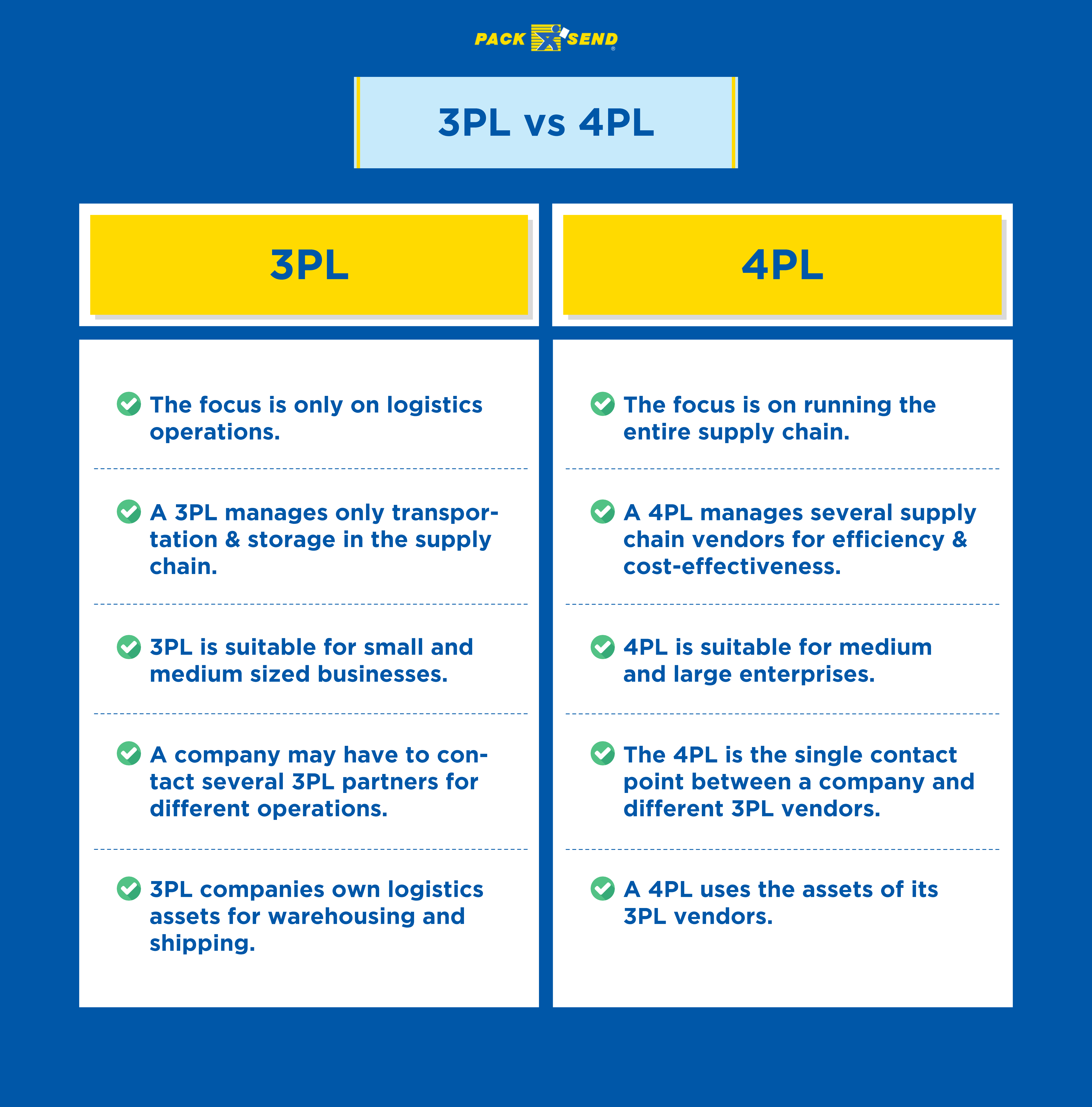
You can also distinguish between 3PL and 4PL based on their resources. A 3PL provider owns logistics assets such as warehouses and freights to facilitate transportation and storage. While the 4PL provider does not own any logistics assets.
In 3PL logistics, the company controls the supply chain and outsources certain services to a logistics company. The company still needs to manage the supply chain and retains oversight of the outsourced logistics. The company is still in charge of designing each stage of the supply chain. The 3PL provider is only assigned a few responsibilities.
But, with 4PL logistics in supply chain management, the company hands over the entire process. The 4PL logistics provider can make decisions to design and alter the supply chain for the benefit of the company.
4PL solutions usually hire 2PL or 3PL service providers to fulfil the logistical requirements of a supply chain. They play the role of a strategic partner and co-ordinator for a company’s supply chain management.
3PL or 4PL: Which One Should You Choose?
Both 3PL and 4PL logistics can help you outsource several operations in a supply chain. While a 3PL service can only facilitate transportation and storage, a 4PL provider takes responsibility for managing the entire supply chain.
The choice between a third party and fourth party logistics boils down to your owned assets and scope of operations. If you only need a partner for order fulfilment for your business, you can pick a 3PL provider. If you want to outsource the entire supply chain operations, you need 4PL solutions.
Stages of 4PL Supply Chain Management
A 4PL solution takes control of several aspects of supply chain management. It handles everything from procurement to order fulfilment. The 4PL provider also acts as a consultant and strategic partner for your business to help you streamline supply chain operations.
Let’s look at the services provided by fourth party logistics:
Supply Chain Planning
A 4PL business can help you plan and execute various aspects of your supply chain. The role of fourth party logistics begins by understanding your business requirements and developing a supply chain strategy that aligns with your goals.
The fourth party logistics provider first needs to consider the various locations within the supply chain. These include:
- Customer Locations
- Retail Locations
- Supplier Locations
- Manufacturing Locations
The 4PL service provider needs to assess the size of inventory movement between different locations. The fourth party logistics company needs to devise a distribution strategy based on the locations and the size of the inventory. They also need to identify strategic locations to store the products during distribution. The storage locations would include warehouses, distribution centres, and fulfilment centres.
Then based on the size of the inventory, the 4PL logistics company has to identify a distribution strategy to move the products through the supply chain. This includes freight forwarding, shipping operations, order fulfilment, and last-mile delivery.
The distribution strategy may involve different types of transportation including road freight, air freight, and ocean freight. If the supply chain spans international markets, the 4PL solution also involves international shipping and customs clearance planning.
While the 4PL model does not rely on owning logistics assets, some fourth party logistics companies control a few assets such as vehicle fleets and warehouses. Although the majority of 4PL providers would hire a 3PL company. Based on the scope of operations, a 4PL solution may need several 3PL partners for different stages of the fourth party logistics supply chain.
Procurement Management
Procurement management is not usually a part of the 4PL solution. However, several fourth party logistics companies do facilitate procurement management. In this stage, the 4PL company arranges the transport and storage of raw materials required for manufacturing products.
The functions of fourth party logistics at this stage depend on the procurement strategy of the company. If the manufacturer orders the inventory in bulk, the 4PL provider would need to arrange for the storage of the inventory. In such cases, there would be two cycles of transportation.
In the first cycle, the logistics provider would transport the inventory from the supplier to a 4PL warehouse. The 4PL company is responsible for keeping the inventory in adequate condition until it is required for production. They also need to monitor the inventory levels and replenish the inventory based on the production schedule.
In the second cycle, the 4PL services transport the inventory from the 4PL warehouse to the production unit. The 4PL company would define a transport schedule from the warehouse to the manufacturing unit based on the production requirements.
On the other hand, the role of fourth party logistics is limited to the transportation of inventory if the company orders the inventory directly to the manufacturing unit. In such cases, the inventory is either stored at the manufacturing location or ordered periodically based on production requirements.
Distribution Logistics
Distribution Logistics is one of the most important services provided by fourth party logistics. At this stage, the 4PL service provider collects the inventory from the manufacturer and distributes it to various warehouses, fulfilment centres, wholesalers, and retail outlets.
The role of fourth party logistics in distribution is to fulfil the inventory requirements at various storage units and points of consumption. The distribution strategy in 4PL logistics depends on several factors. These include:
- Location of Manufacturing Units
- Size/Volume of Inventory
- Target Markets
- Demand Forecasts
- The number of Storage Units/Retail Outlets
- Locations of Storage Units/Retail Outlets
- Inventory Requirements at Storage Units/Retail Outlets
These variables define the scope of operations for distribution logistics in the 4PL model. For example, if the company has retail outlets in just one city. The 4PL provider can use a warehouse close to the city to store inventory and distribute it to the retail outlets as needed.
Furthermore, if the inventory demand is consistent with the production schedule. The 4PL logistics service can use the cross-docking method to transport inventory directly to the retail outlets.
But, if the company needs to facilitate numerous retail outlets in several cities, the 4PL company needs a more complex model for logistics distribution. 4PL distribution logistics would also involve international shipping and customs clearance if the manufacturer and customers are in different countries.
Example of 4PL Logistics Distribution
Let’s say a company has its manufacturing unit in Canberra and wants to distribute products all across Australia. The 4PL solution provider will need to identify strategic locations for warehouses and distribution centres in different zones.
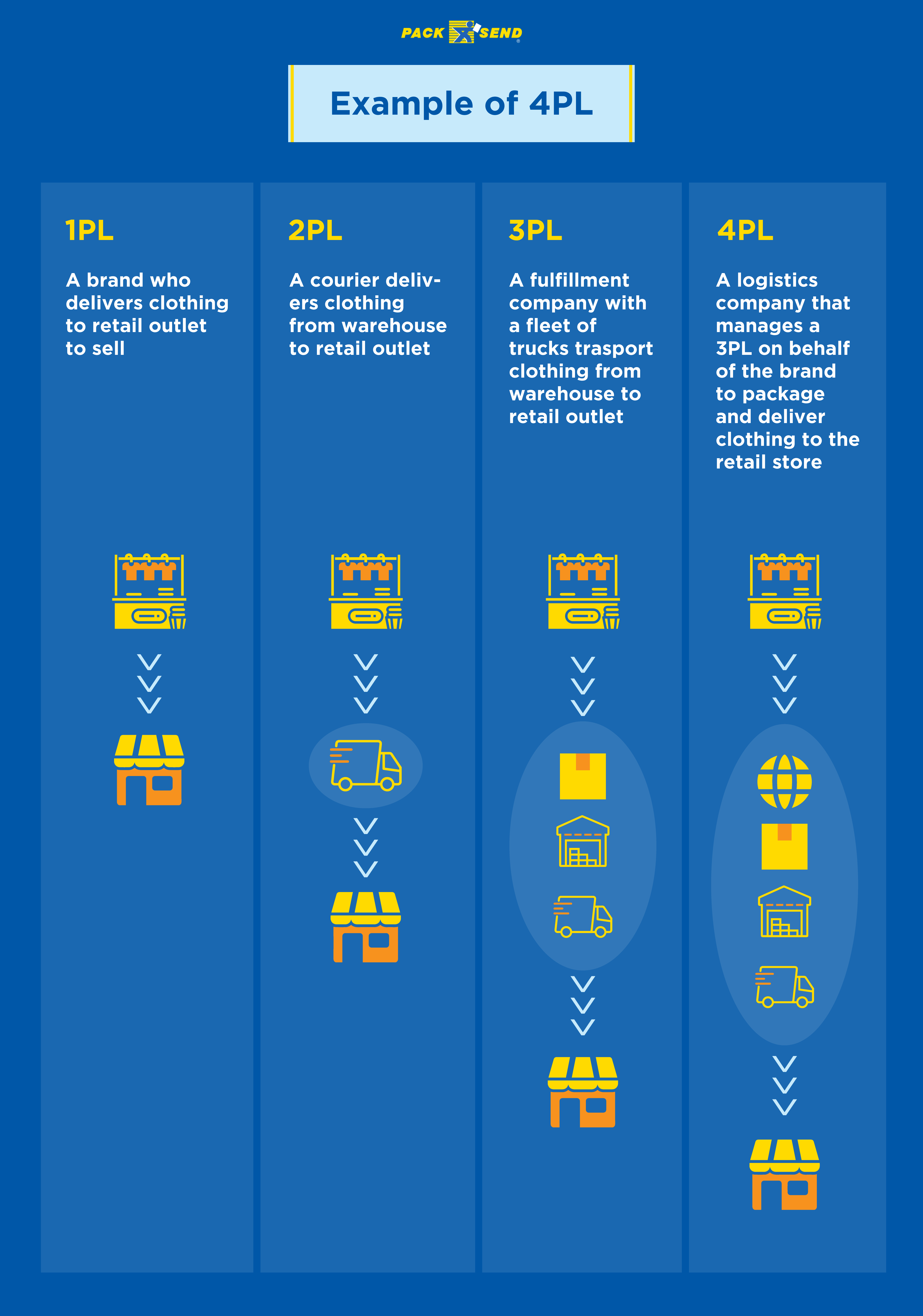
In such cases, the 4PL supply chain might also require a central storage unit that is either close to the manufacturing unit or adequately distanced from the zonal distribution centres. If certain cities have exceptionally high inventory requirements, the 4PL provider will need additional distribution centres close to those cities as well.
The 4PL provider needs to plan each cycle of transport based on several criteria. These include:
- Inventory Size
- Transport Distance
- Freight Regulations
In this example, the role of fourth party logistics would be as follows:
- Transport inventory from the manufacturing unit to the central warehouse
- Transport inventory from the central warehouse to zonal warehouses
- Transport inventory from zonal warehouses to distribution centres
- Transport inventory from distribution centres to retail outlets
Alongside transportation, storage also falls under the purview of fourth-party logistics in supply chain management.
Warehousing
4PL warehousing goes beyond merely storing inventory. In the 4PL model, the logistics partner first needs to identify strategic locations for storage units. These can include warehouses, distribution centres, fulfilment centres, and micro fulfilment centres.
The 4PL service provider first needs to estimate inventory demand in different regions. They also need to consider the demand based on points of consumption in different regions. If the point of consumption is a retail outlet, then the 4PL solution will need a distribution centre. On the other hand, the 4PL provider will need fulfilment centres if the demand is for eCommerce order fulfilment.
Once the fourth party logistics company identifies strategic locations for storage units, they will hire 3PL services or storage providers in those locations. The 4PL services may need to coordinate with several 3PL companies for warehousing in different locations. But, the 4PL company remains the sole point of contact for the manufacturer.
The 4PL provider also needs to check each storage facility to confirm that it has the necessary space and resources to store the manufacturer’s products. They also need to check the inventory management capabilities of the 3PL companies for warehousing.
Once all quality checks are done, the 4PL warehouse can receive and store products. Alongside storage, a 4PL warehouse is also responsible for inventory management.
Inventory Management
In the 4PL model, inventory management is usually done by the 3PL service provider. The 4PL company is responsible for defining the policy for inventory management and monitoring the performance of the 3PL service provider.
The role of fourth party logistics is to monitor inventory levels at various storage locations. They also need to define ideal inventory levels for each storage unit. The 4PL supply chain needs to adjust the inventory supply to each location based on the inventory levels and demand forecasts.
They also need to report instances of overstocking and understocking to their clients. This will help them align the production schedule with the inventory levels in different 4PL warehouses.
Alongside inventory management, the 4PL warehouses are also responsible for picking and packaging products for distribution and order fulfilment.
Order Fulfilment & Reverse Logistics
Order fulfilment and reverse logistics usually fall under distribution. But, these are individually quite significant 4PL logistics solutions for eCommerce businesses. Both of these aspects of the 4PL supply chain have a huge impact on eCommerce sales.
Slow delivery and high shipping costs are among the top reasons for cart abandonment. While free and fast delivery along with easy returns are among the top factors to influence purchase decisions for online shoppers.
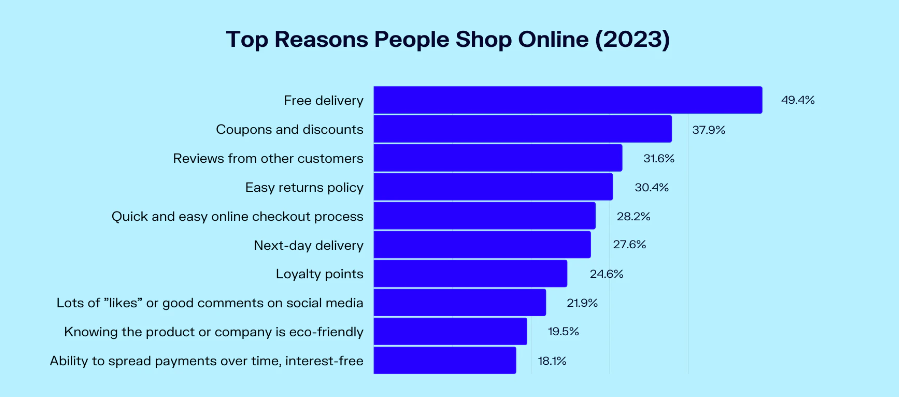
A 4PL service provider needs to plan the supply chain to facilitate fast delivery at the lowest possible cost. They may use a variety of transportation services and strategic micro fulfilment locations to reduce the time and cost of delivery.
The fourth party logistics business may hire a 3PL partner, order fulfilment partner, or domestic delivery service provider for order fulfilment and reverse logistics. The 4PL provider also ensures that the delivery is done as per the brand’s guidelines. For instance, if the brand requires blind shipping, the 4PL provider has to set packaging stands accordingly. The 4PL system communicates necessary information about the delivery to the logistics partner.
They also communicate the details and progress of the delivery status with the manufacturer and the customer. Then the 4PL company serves as a mediator between logistics, the manufacturer, and the customer.
Analysis and Optimisation
The primary function of a fourth party logistics company is to design the supply chain and keep it running smoothly. This requires constant performance analysis at various stages of the supply chain. A 4PL provider would analyse key performance indicators in supply chain and distribution metrics. Based on this information they identify opportunities for improvement and cost reduction.
The 4PL solution also needs to optimise the supply chain to keep up with industry trends and best practices. Furthermore, it is also their job to calibrate the supply chain as per business requirements.
For example, let’s say a company shifts from multichannel to omnichannel retailing. In this case, the 4PL supply chain needs alterations to fit the new business model. This would require changes in warehousing, logistics distribution, inventory management, and order fulfilment processes.
The 4PL provider would identify new vendors or renegotiate contracts with existing vendors to optimise the supply chain for speed, efficiency, sustainability, and cost-effectiveness.
Example of 4PL
Let’s look at fourth party logistics examples by comparing them with other distribution models. In this example, we will see how the supply chain of a brand operates in different models.
The 4PL company coordinates the movement of inventory across the supply chain through its 3PL partners. But, the brand only needs to coordinate with its 4PL provider. In this model, the execution is carried out by one or more 3PL providers. The function of the 4PL solution is to provide strategic insight to run and improve the supply chain on behalf of the brand.
The 4PL model can work for companies of all sizes. But, it is more commonly used by large enterprises with complex supply chains that span several territories.
There are several companies that provide 4PL logistics services. Some of the well-known examples of 4PL solutions include DHL Supply Chain, UPS Supply Chain Solutions, Accenture Consulting, 4PL Group, and 4PL Insights.
Benefits of 4PL
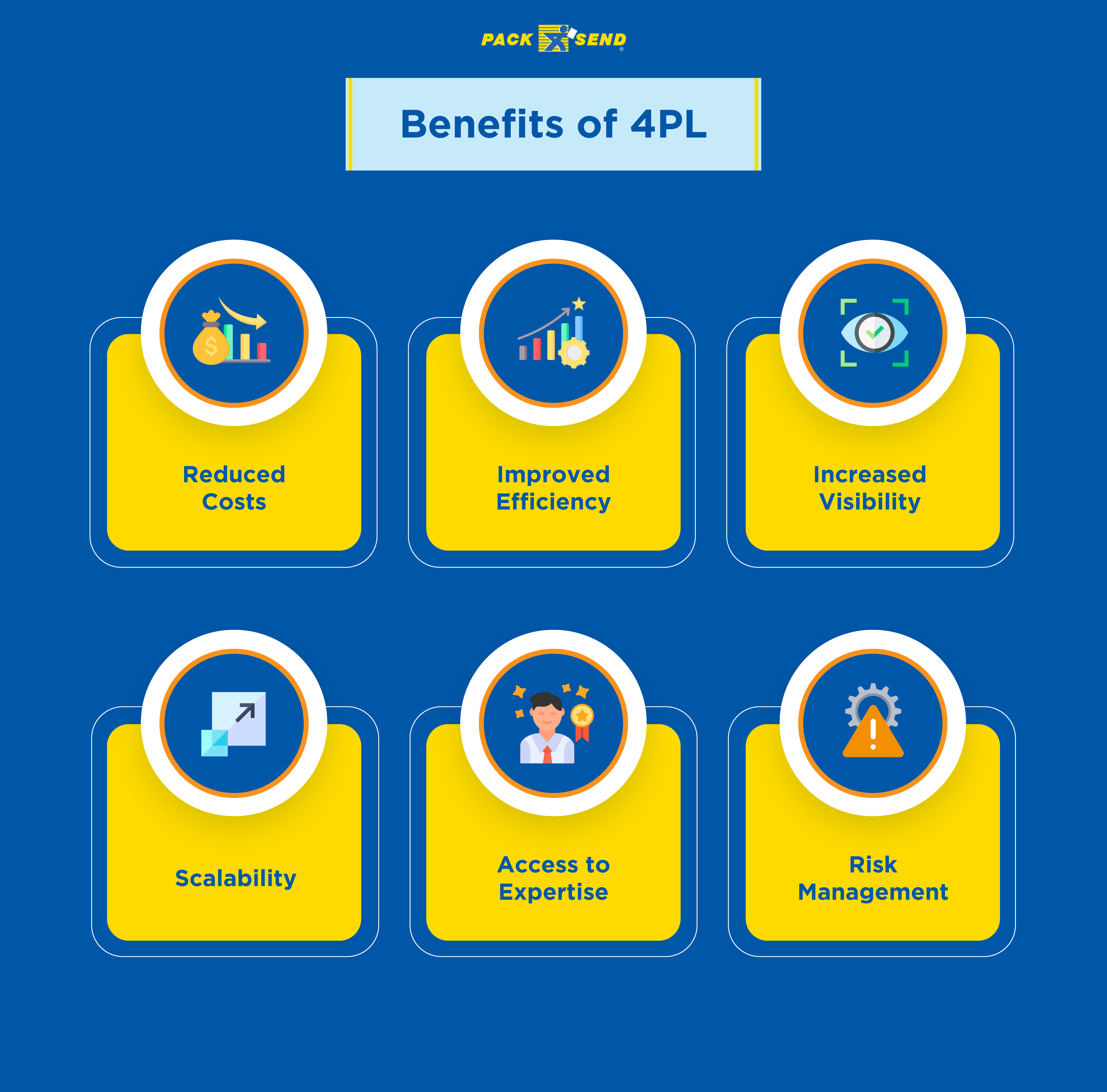
A 4PL solution can ease the burden of a company by taking control of the supply chain. Here are a few benefits of hiring a 4PL partner for your organisation:
Reduced Costs
One of the primary benefits of 4PL logistics is cost reduction. 4PL providers leverage their network of carriers, suppliers, and other logistics service providers to negotiate better rates and optimise transportation routes. They can also consolidate shipments and manage the entire logistics process, resulting in cost savings for the organisation.
Improved Efficiency
By outsourcing logistics management to a 4PL provider, organisations can focus on their core competencies and leave logistics operations to the experts. This results in increased efficiency and productivity, as the organisation can allocate resources to its core business functions.
The 4PL provider can also use advanced logistics technology and data analytics to optimise transportation routes, reduce transit times, and improve inventory management, resulting in further efficiency gains.
Increased Visibility
4PL providers use advanced logistics technology solutions that provide real-time visibility of inventory, transportation, and other logistics data. This enables organisations to make informed decisions and respond quickly to changing market conditions.
For example, if a shipment is delayed, the organisation can quickly adjust its production schedule or communicate with customers about potential delays. Real-time visibility also enables organisations to track inventory levels and optimise supply chain operations to reduce stockouts and improve customer service.
Scalability
4PL providers offer scalable logistics solutions that can easily adapt to the organisation's changing requirements. For example, if the organisation experiences rapid growth, the 4PL provider can quickly scale up logistics operations to handle increased volumes.
Similarly, if the organisation experiences a downturn or a shift in market conditions, the 4PL provider can adjust logistics operations to match the new requirements. This enables organisations to respond quickly to changing market conditions and remain agile and competitive.
Access to Expertise
4PL providers have specialised logistics expertise and knowledge. They can provide guidance and recommendations on logistics best practices, and identify areas for improvement in the organisation's logistics operations.
For example, the 4PL provider may identify opportunities for the organisation to optimise transportation routes or improve inventory management practices. This expertise can help organisations streamline logistics operations and reduce costs.
Risk Management
4PL providers can help organisations manage risks related to transportation, compliance, and security. For example, the 4PL provider may conduct regular audits of carriers and suppliers to ensure compliance with regulations and safety standards.
In the absence of a 4PL partner, an organisation risks its owned resources for the supply chain management. Any damages can result in heavy expenses and setbacks. By using 3PL and 4PL solutions, an organisation can run its operations using external resources. The company does not have to bear any expenses in case of damages. Furthermore, the responsibility of overcoming setbacks in the supply chain falls upon the 4PL provider.
They can also monitor shipments in real-time to ensure they arrive at their destination safely and securely. This reduces the risk of disruptions to logistics operations and ensures the safety and security of goods in transit.
Conclusion
A 4PL provider can help you manage the entire supply chain without intervention. They can find the right logistics vendors to fulfil your storage and transportation requirements. The fourth party logistics company will also help you optimise the supply chain for cost reduction and efficiency. This will allow you to direct your efforts and resources towards other aspects of your business.
On the other hand, you should choose a 3PL partner, like PACK & SEND, if you still want to retain control over the supply chain and use third-party logistics resources such as warehousing, inventory management, and logistics distribution.
Frequently Asked Questions (FAQs)
What does 4PL mean?
4PL stands for fourth party logistics. The term was coined by Accenture to define a logistics company that serves as a consultant and integrator for supply chain management. A 4PL helps a company design its supply chain. The fourth party logistics provider also serves as the controlling body as well as a single point of contact for supply chain operations.
What is an example of 4PL Logistics?
Shopify Fulfilment Network (SFN) is an example of 4PL logistics. An eCommerce brand hires SFN to manage order fulfilment for its eCommerce customers. SFN defines the supply chain operations including warehousing, inventory management, packaging, order fulfilment, and last-mile delivery.
Then SFN hires one or more 3PL partners to carry out these operations for the brand. While SFN serves as the representative of the eCommerce brand to manage the 3PL partners and run the supply chain.
What are 3PL and 4PL in Logistics?
3PL and 4PL logistics are both models of supply chain management. In the 3PL logistics model, a company outsources storage and transportation-related operations to a logistics company. The 4PL logistics model is an extension of the 3PL model. With 4PL, the logistics company manages several 3PL providers on behalf of the company to run its supply chain.
Who are 4PL Providers?
A 4PL provider is a logistics company that specialises in managing the entire supply chain on behalf of other companies. They partner with several 3PL providers to fulfil various supply chain operations. The 4PL provider acts as a strategist, consultant, and coordinator for the company’s supply chain management.
Why would a company choose to use a 4PL solution?
A 4PL solution can help a company simplify its business operations by delegating supply chain planning and management to a logistics company. The 4PL provider takes care of all operations including order management, warehousing, inventory management, distribution logistics, packaging, order fulfilment, reverse logistics, and so on. This allows the company to focus on other business operations.
Image Source: Oberlo
